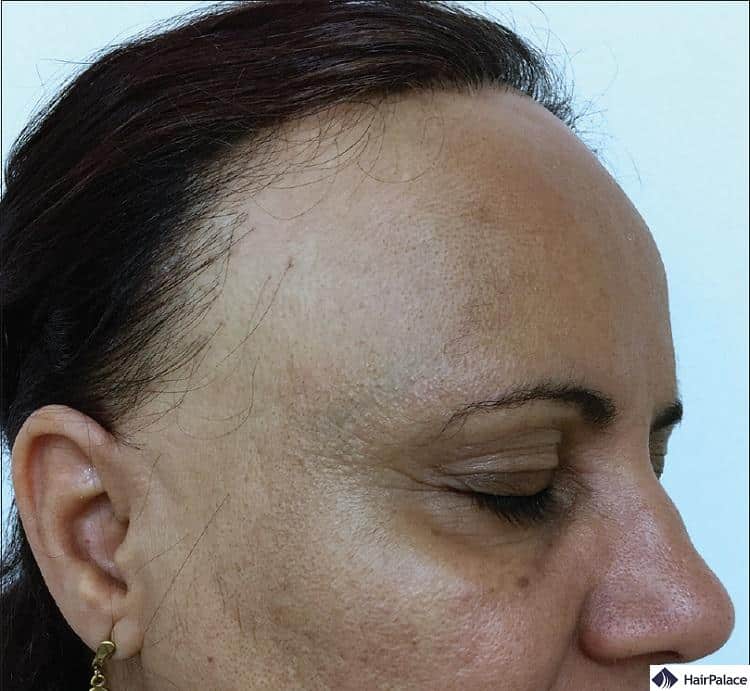Frontal Fibrosing Alopecia Explained

Frontal fibrosing alopecia (FFA) is a rare hair loss condition that causes both progressive hair loss and permanent scarring across your hairline.
Though often presenting as postmenopausal frontal fibrosing alopecia, younger men and women can still develop the condition.
If you’re currently suffering from FFA and looking for answers, we’re here to help.
This article will discuss front fibrosing alopecia in detail.
We’ll explain the condition’s common symptoms and treatment plans and what research tells us about its potential causes.
We’ll also recommend ways to protect your hair and slow its progression, helping you to limit possible hair loss in the future.
What is frontal fibrosing alopecia?
Frontal fibrosing alopecia is a progressive hair loss condition mainly targeting your hairline, eyebrows, and temples.
Symptoms include hair thinning, a receding hairline, and bald patches developing in affected areas, including your eyebrows.
Over time, this hair loss may spread to the back and sides of your head.
Because early symptoms are similar to other hair loss conditions like female pattern baldness, FFA can initially be quite difficult to distinguish.
For that reason, visiting your doctor or dermatologist is highly recommended.
Research is still growing around frontal fibrosing alopecia, and we cannot say how or what triggers it, but we can compare it to similar-acting conditions.
What causes frontal fibrosing alopecia
Unfortunately, there is still so much we don’t know about the causes of frontal alopecia female.
This can make it challenging to determine the exact cause and find the appropriate treatment, especially early on.
As a form of lichen planopilaris (scarring alopecia), FFA acts like an autoimmune disease, where your body’s immune system mistakenly attacks healthy cells, mainly the hair follicles.
There are some causes currently being investigated. Both doctors and scientists have theories that the root cause of FFA may include:
1. Genetics
Scientists are investigating whether people have a genetic predisposition to rare diseases like FFA.
If someone in your family has been diagnosed, this can increase your likelihood.
Women of African descent may show symptoms earlier than other ethnicities.
2. Environmental triggers
Some people believe that exposure to harsh chemicals commonly found in dyes, paints, and even pesticides might trigger scarring hair loss.
Sun exposure, infections, and viruses may also trigger it.
3. Hormonal changes
Frontal fibrosing alopecia male is much less common.
So some believe it is linked to hormonal changes, such as when on birth control, following pregnancy or menopause, or suffering from pre-existing conditions like female pattern baldness.
4. Lifestyle triggers
Long periods of stress can release harmful hormones that affect hair growth and quality.
It is thought that stress may trigger the autoimmune reaction many people report when diagnosed with FFA.
5. Medication
Because many link FFA with your immune system, it’s thought that certain medications can have adverse effects on your body and trigger the condition, especially with cholesterol and high blood pressure treatments.
Symptoms of frontal fibrosing alopecia

Specific characteristics of FFA set it apart from other hair loss conditions.
The most common is the developing patchy areas of hair loss with small scarring along the scalp, hair margin, and temples.
Over time, the hairline may recede further back, and hair begins to thin considerably across the scalp.
You may also experience severe itchiness, and tenderness and feel burning in and around your frontal hairline.
Other symptoms include scalp inflammation, skin scaling, and general irritation in the affected area.
Small, yellow-coloured bumps, known as facial papules, may appear.
These bumps have no visible hair follicle opening and can be mistaken for sun damage.
Oral isotretinoin can be used to reduce their appearance.
Finally, you may notice a change in hair quality, texture, and strength.
FFA can cause hair to become brittle and fragile and can snap off easily from your hair.
Unfortunately, FFA is a progressive condition, meaning that as time moves on, it can get increasingly worse for patients.
You may experience extensive hair loss or even complete baldness.
For that reason, seeking medical advice and treatment is highly recommended.
How is frontal fibrosing alopecia diagnosed?
A dermatologist is the best person to diagnose frontal fibrosing alopecia formally.
They will conduct several tests on your hair follicles and look for diagnostic clues.
As a variation of lichen planopilaris, one of the easiest and most effective tests is the hair pull test, where your dermatologist pulls about forty strands gently.
They will then examine how many strands fell out.
Six or more is usually a sign of a hair loss condition and will require further attention.
Your dermatologist will also closely examine the pattern distribution of hair loss across your scalp, hairline, and other body areas.
They may also ask you about your family history, including a history of hair loss conditions or autoimmune diseases.
Finally, your dermatologist may conduct a small skin biopsy.
This perfectly safe procedure gives your doctors more information about your skin’s health.
Treatment for frontal fibrosing alopecia

Following your diagnosis, your dermatologist will discuss the various treatment options for fibrosing alopecia.
Depending on your current condition, they might recommend the following:
- Topical medication: Though not a cure, topical medications like Minoxidil can greatly slow hair loss progression. That said, you will need to continue treatment to maintain results.
- Oral medication: In severe cases, prescriptions like finasteride or spironolactone may be effective. These both work on a biological level, blocking the sex hormone dihydrotestosterone (DHT) from being produced. They have side effects you must be aware of before starting treatment.
- Lifestyle changes: Simple changes can protect your hair follicles and prevent future hair loss. Eating a more nutritious diet, managing stress, and exercising can help improve your health and well-being. Additionally, avoiding using heat-styling devices and harsh chemical treatments and wearing tight hairstyles can reduce your chances of developing traction alopecia.
- Non-surgical solutions: PRP for frontal fibrosing alopecia is believed to support hair growth and aid hair health. It might be beneficial to try PRP treatment to promote healthy hair growth and potentially prevent further hair loss.
Vitamins for frontal fibrosing alopecia
To have a healthy body and hair you must ensure an adequate intake of vitamins.
Vitamins for frontal fibrosing alopecia can help prevent and treat symptoms, so improving your intake is highly recommended.
So what vitamins should you focus on?
Vitamin A is one of the most important, as it’s known to help produce sebum, which keeps skin and hair hydrated.
Vitamin D can also help frontal fibrosing alopecia because it helps stimulate hair follicles to grow and support new strands.
A Vitamin D deficiency is often linked to different forms of alopecia.
Vitamin E is also considered incredibly important, as it has antioxidant properties that help reduce inflammation, thus improving growing conditions for hair follicles.
Hairstyles for frontal fibrosing alopecia
There are several ways to hide your condition with the help of certain hairstyles and tricks, some of these include:
- Side Sweep: Part your hair on the side and sweep the longer portion over the forehead to cover the receding hairline.
- Soft Bangs: Depending on the progression of the FFA, soft bangs can help cover the front hairline. These should be light and wispy to reduce weight and tension.
- Short Cuts: Pixie cuts or short bob cuts can reduce the visual impact of the receding hairline by creating an overall balanced look.
- Volume on Top: Styles that add volume to the top and crown of the head can draw attention away from the hairline. This can be achieved by using volumizing products and gentle teasing.
- Accessorize: Use headbands, scarves, or hats. They not only camouflage hair loss but can also make a fashion statement.
- Wig or Hairpiece: Consider investing in a good quality wig or hairpiece. This can provide the appearance of a full head of hair and can be styled in various ways. Try searching for hairpieces for frontal fibrosing alopecia UK online and find a piece that suits your style.
- Soft Waves or Curls: If you have longer hair, introducing waves or curls can add volume and distract from frontal hair loss.
How do I take care of myself with frontal fibrosing alopecia?
It can be an incredibly stressful and emotional thing to lose your hair.
It’s important to remember that help and support are available at every step of your journey.
One of the most effective things you can do early on is to join an alopecia support group.
This will allow you to share your experiences and learn from others in a safe, caring environment.
You can also talk to your family, friends, doctor, or therapist for emotional support.
You can also make simple styling changes to help alleviate symptoms, such as avoiding heat styling tools like straighteners and curling tongs, tight hairstyles that pull on your strands, and hair dyes and perms.
When should you see a doctor?
When you experience sudden or severe hair or eyebrow loss, visit your doctor immediately.
Getting a formal diagnosis will ensure that you start effective treatment early and that you can limit or even prevent further hair loss from taking place.
Frontal Fibrosing Alopecia FAQ
Although fibrosing alopecia is still fairly uncommon, many people are diagnosed worldwide yearly. As time passes, we will learn more about the condition and develop better treatments and clinical trials.
Depending on the treatment you undergo, you can expect to see noticeable improvements from treatment within six to 18 months.
Every person is unique, and experiences with rare diseases like FFA can vary greatly. Some people may suffer a receding hairline or balding in patches or zigzag patterns; for others, hair loss might stop spontaneously.
FFA is a form of scarring alopecia, and the hair loss it causes is permanent. Treatments may help halt its progression but cannot reverse the hair loss that has already occurred.
Frontal fibrosing alopecia is believed to have an autoimmune component, but it is not caused by a specific known autoimmune disease. The exact cause of FFA remains unclear.
The progression of FFA can often be slowed or halted with appropriate treatment, but the condition itself cannot be reversed.
Last medically reviewed on June 3rd, 2024
- Vañó-Galván S, Molina-Ruiz AM, Serrano-Falcón C, Arias-Santiago S, Rodrigues-Barata AR, Garnacho-Saucedo G, Martorell-Calatayud A, Fernández-Crehuet P, Grimalt R, Aranegui B, Grillo E. Frontal fibrosing alopecia: a multicenter review of 355 patients. Journal of the American Academy of Dermatology. 2014 Apr 1;70(4):670-8.https://doi.org/10.1016/j.jaad.2013.12.003
- Tan KT, Messenger AG. Frontal fibrosing alopecia: clinical presentations and prognosis. British Journal of Dermatology. 2009 Jan 1;160(1):75-9.https://doi.org/10.1111/j.1365-2133.2008.08861.x
- Iorizzo M, Tosti A. Frontal fibrosing alopecia: an update on pathogenesis, diagnosis, and treatment. American journal of clinical dermatology. 2019 Jun 1;20:379-90.https://doi.org/10.1007/s40257-019-00424-y
- Fertig R, Tosti A. Frontal fibrosing alopecia treatment options. Intractable & rare diseases research. 2016;5(4):314-5.https://doi.org/10.5582/irdr.2016.01065


